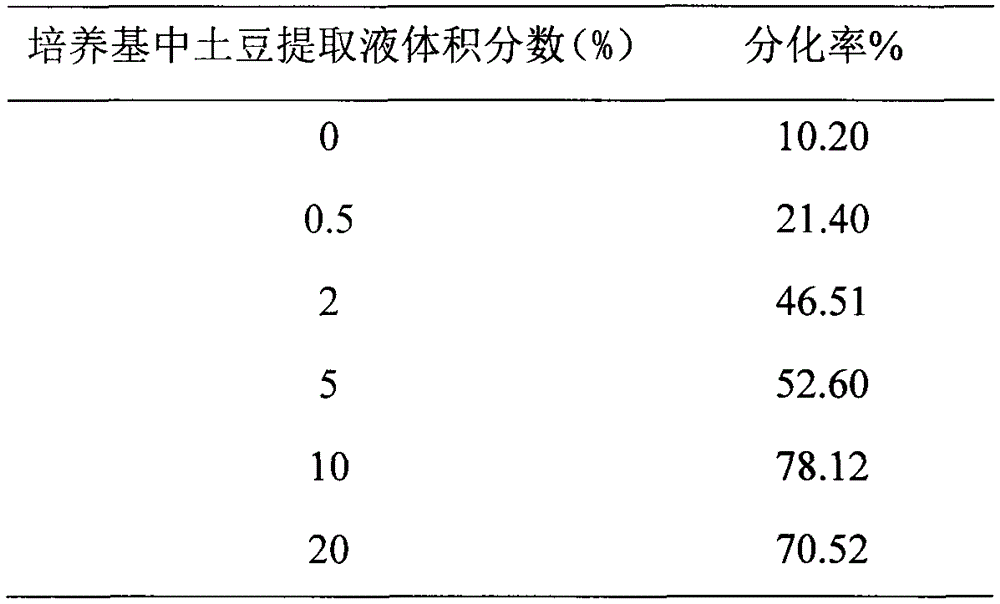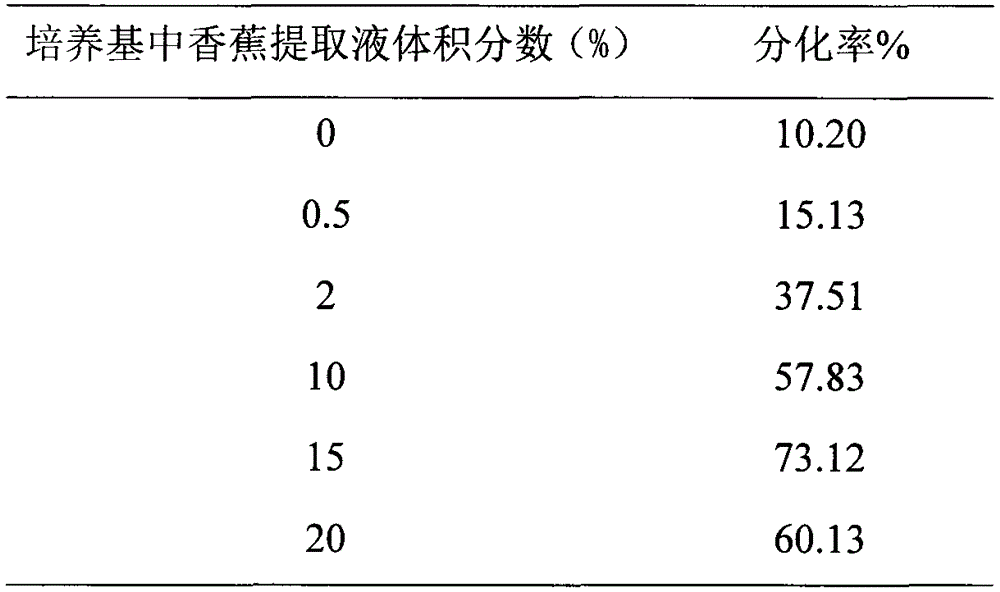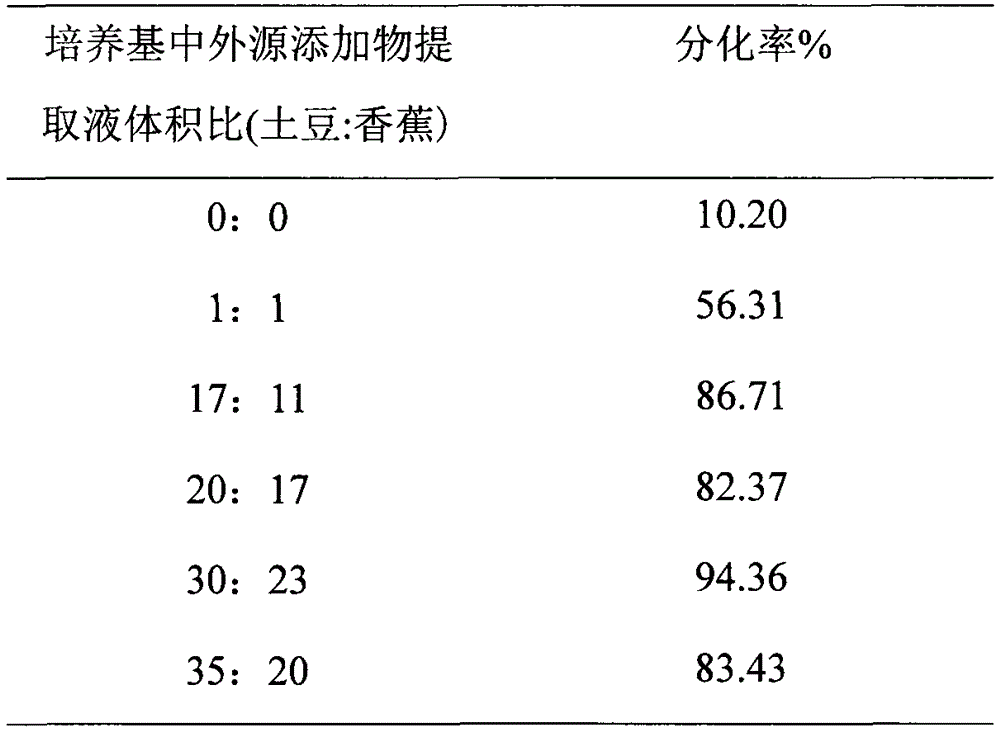Exogenous additive culture medium for promoting differentiation of anoectochilus formosanus protocorm
An exogenous additive and protocorm differentiation technology, applied in the biological field, can solve the problems of harsh growth environment, endangered wild resources of clematis, and difficult artificial cultivation, etc., and achieve the effect of protecting wild resources
- Summary
- Abstract
- Description
- Claims
- Application Information
AI Technical Summary
Problems solved by technology
Method used
Image
Examples
Embodiment 1
[0016] Take 2 cm of the stem section of Aurantia clematis with joints, soak it in washing powder solution for 6 minutes, wash it with running water for 2 hours, disinfect it with 75% alcohol on a sterile ultra-clean table for 20 seconds, wash it with sterile water for 3 times, and then wash it in 0.1% mercury chloride solution. Sterilize for 8 minutes, wash 6 times with sterile water, cut off both ends of the sterilized stem segment with a scalpel, and inoculate it in MS medium containing 2.0mg / L of 6-BA and 0.2mg / L of NAA , the culture temperature is 25±1°C, the light is 15001x, the light time is 12h / d, and the air humidity is kept at 50%-60%. After 30 days, protocorms grow at both ends of the stem segment.
[0017] After the obtained clematis protocorms were subcultured in the above medium and grown for 30 days, they were cut into 2cm 2 size, inoculated into the differentiation medium, and observed the differentiation phenomenon after 45 days. The composition of medium A is...
Embodiment 2
[0023] Take 2 cm of the stem section of Aurantia clematis with joints, soak it in washing powder solution for 6 minutes, wash it with running water for 2 hours, disinfect it with 75% alcohol on a sterile ultra-clean table for 20 seconds, wash it with sterile water for 3 times, and then wash it in 0.1% mercury chloride solution. Sterilize for 8 minutes, wash 6 times with sterile water, cut off both ends of the sterilized stem segment with a scalpel, and inoculate it in MS medium containing 2.0mg / L of 6-BA and 0.2mg / L of NAA , the culture temperature is 25+1°C, the light is 1500lx, the light time is 12h / d, and the air humidity is kept at 50%-60%. After 30 days, protocorms grow at both ends of the stem segment.
[0024] After the obtained clematis protocorms were subcultured in the above medium and grown for 30 days, they were cut into 2cm 2 size, inoculated into the differentiation medium, and observed the differentiation phenomenon after 45 days. The composition of medium A is...
Embodiment 3
[0030] Take 2 cm of the stem section of Aurantia clematis with joints, soak it in washing powder solution for 6 minutes, wash it with running water for 2 hours, disinfect it with 75% alcohol on a sterile ultra-clean table for 20 seconds, wash it with sterile water for 3 times, and then wash it in 0.1% mercury chloride solution. Sterilize for 8 minutes, wash 6 times with sterile water, cut off both ends of the sterilized stem segment with a scalpel, and inoculate it in MS medium containing 2.0mg / L of 6-BA and 0.2mg / L of NAA , the culture temperature is 25±1°C, the light is 1500lx, the light time is 12h / d, and the air humidity is kept at 50%-60%. After 30 days, protocorms grow at both ends of the stem segment.
[0031] After the obtained clematis protocorms were subcultured in the above medium and grown for 30 days, they were cut into 2cm 2 size, inoculated into the differentiation medium, and observed the differentiation phenomenon after 45 days. The composition of medium A is...
PUM
 Login to View More
Login to View More Abstract
Description
Claims
Application Information
 Login to View More
Login to View More - R&D
- Intellectual Property
- Life Sciences
- Materials
- Tech Scout
- Unparalleled Data Quality
- Higher Quality Content
- 60% Fewer Hallucinations
Browse by: Latest US Patents, China's latest patents, Technical Efficacy Thesaurus, Application Domain, Technology Topic, Popular Technical Reports.
© 2025 PatSnap. All rights reserved.Legal|Privacy policy|Modern Slavery Act Transparency Statement|Sitemap|About US| Contact US: help@patsnap.com



